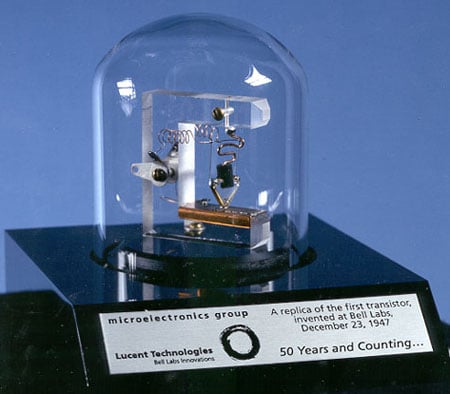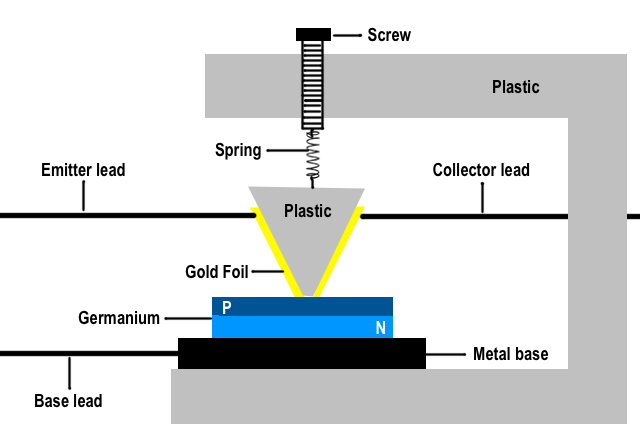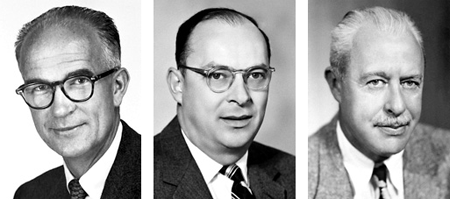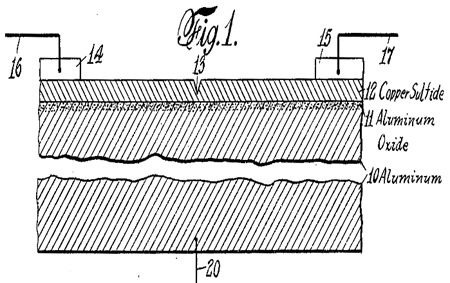Original URL: https://www.theregister.com/2012/12/14/feature_the_transistor_is_65_years_old/
Happy birthday, transistor
The first working version powered up 65 years ago
Posted in Personal Tech, 14th December 2012 12:00 GMT
The transistor, the ubiquitous building block of all electronic circuits, will be 65 years old on Sunday. The device is jointly credited to William Shockley (1910-1989), John Bardeen (1908-1991) and Walter Brattain (1902-1987), and it was Bardeen and Brattain who operated the first working point-contact transistor during an experiment conducted on 16 December 1947.
Yet this now ubiquitous device - these days more as an element in silicon chip design than as a discrete component - has a history that goes back to the mid-1920s.

Bardeen and Brattain's transistor, as replicated in 1997
The name isn’t 65 years old, either. It wasn't coined in 1947. Bell Labs employee John R Pierce (1910-2002) thought up the moniker, and in May 1948 his colleagues, who'd been presented with a list of names the new device might be named, opted for his.
”This is an abbreviated combination of the words ‘transconductance’ or ‘transfer’, and ‘varistor’,” Bell Labs’ voting paper put it at the time.
The team's work goes back to the late 1930s, but the real work didn't begin until after the end of World War II. Shockley proposed a field-effect transistor design that would be made out of thin slices of different semiconductors, including silicon, sandwiched together. Unfortunately, he wasn't able to get this design to work the way his maths anticipated, and so Bardeen and Brattain chose to investigate the simpler, surface-effect point-contact design.
The two men produced the first point-contact transistor by attaching two gold-foil point contacts to a piece of germanium, itself mounted on a metal base. The gold sheets were kept apart with a wedge of plastic. Originally a single sheet of gold, the very closely-sited contacts were made by slicing the sheet at the apex of the triangle.
This time it worked, and Bardeen and Brattain were able to extend their apparatus with circuitry able to amplify sound signals, much to the delight of their Bell Labs bosses.

The structure of the first point-contact transistor
The company would go on to put the point-contact transistor into limited production, announcing the device to the public on 1 July 1948. By then, Shockley had already developed an alternative design and the point-contact device's successor: the bipolar junction transistor. His invention, built and tested in January 1948, made for a more compact design and proved, in time, to be easier to manufacture than the bulky point-contact transistor.
It went on to become the basis for all the transistors used in electronics products right up until the broad use of Complementary Metal–Oxide Semiconductor (CMOS) technology in the late 1960s following the discovery of the MOS by Bell Labs' John Atalla and Dawon Kahng in 1959, though their patent application wasn’t registered until 31 May 1960. It was granted on 27 August 1963.
Bell was finally able to put Shockley's junction transistor mass production in 1952, and afterwards licensed the design to other firms too, most notably a new, small Japanese company called Sony. Two years later, Bell replaced the germanium used in its transistors with silicon.
Nobel team
Shockley, Bardeen and Brattain won the Nobel Prize for Physics “for their researches on semiconductors and their discovery of the transistor effect” in 1956, almost two years after their work resulted in the release of the first transistor radio.

From Bell to Nobel: Shockley, Bardeen and Brattain
These early transistors were used primarily to amplify an analog signal, which they were better able to achieve - certainly in a much smaller space - than circuits based on thermionic valves. Only much later, after Jack Kilby (1923-2005) and Robert Noyce (1927-1990) combined transistors into the first integrated circuit chip, in 1958, did the potential in the transistor's ability to operate as a switch begin to be realised.
Transistors operating as current switches could be combined to form logic gates and when they were, the basic foundations of modern digital circuitry were born. Put a number of these gates together into an integrated circuit and you have the basis for a computer. Put enough of them together and you have a microprocessor, which Intel released in 1971 as the 2300-transistor 4004.
These days, processors contain hundreds of millions of transistors, making up their maths units, control systems and on-board memory banks.
The Transistor's Real Inventor?
Years before the work of Shockley, Bardeen and Brattain, German physicist Julius Edgar Lilienfeld (1881-1963) obtained three US patents that covered the principles on which the field-effect transistor operates. A few years later, fellow German physicist Oskar Heil (1908-1994) was granted a field-effect device patent of his own. Should Lilienfeld and Heil be credited as the fathers of the transistor?
Heil's patent was granted in the UK on 6 December 1935 and derived from an application made on 4 March the previous year, in Germany and in Britain, where Heil was working. Lilienfeld's first patent - “Method and Apparatus for Controlling Electric Currents” - was granted in the US on 28 January 1930, four years after it was filed, on 8 October 1926. Lilienfeld's second patent - “Device for Controlling Electric Current” - was filed on 28 March 1928 and granted on 7 March 1933.
Lilienfeld’s devices have since been made and show to work as he predicted, but it’s not known whether he himself made one. Or Heil, for that matter. We'll probably never know if they did, which leaves Bardeen and Brattain credited as the men who made the first working transistor.
They applied for patent to protect their discovery on 17 June 1948. It was granted on 3 October 1950.

Lilienfeld’s field-effect transistor
It has been claimed that Shockley, for one, was aware of Lilienfeld’s work, and built a working version of a Lilienfeld transistor. However, Shockley never referred to either Heil or Lilienfeld’s work in his own research papers.
And then there are German physicists Herbert Mataré (1912-2011) and Heinrich Welker (1912-1981), who created a point-contact transistor of their own during 1948. By June of that year, they had begun to obtain consistent amplification - only to learn, a month later, that Bell Labs’ team had beaten them to it some six months previously.
That didn't stop them putting their “transistron” into production, but like Bardeen and Brattain’s design, it would soon be superseded by Shockley’s junction transistor. ®